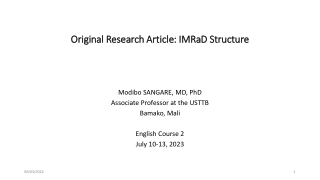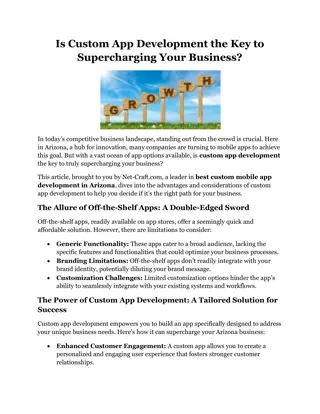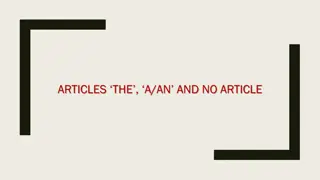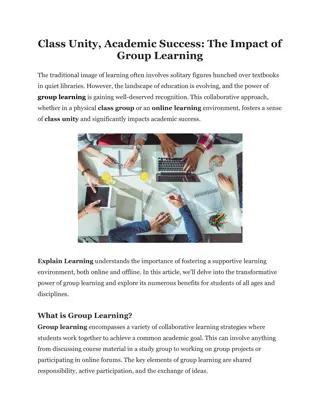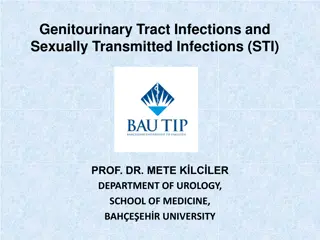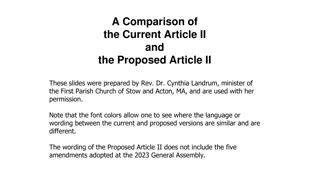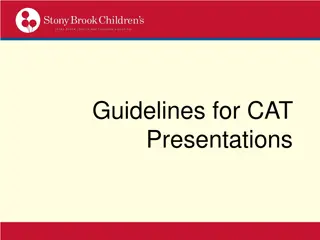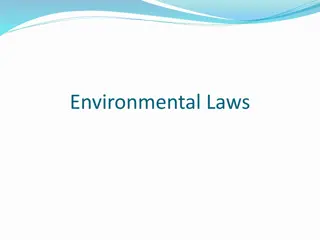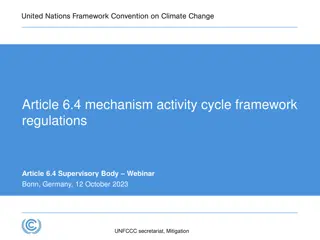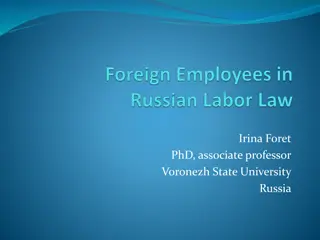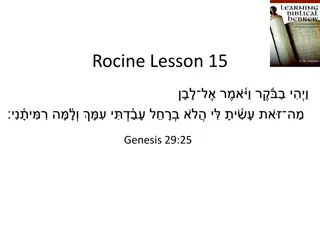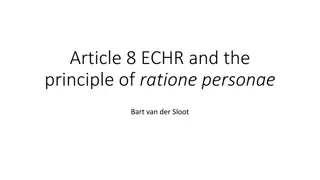Article
Preparation of a narrative review article involves understanding, following, and implementing the steps outlined in the process. Abdul Rohman from the Faculty of Pharmacy at Gadjah Mada University shares insights and tips on this academic writing process, emphasizing the importance of structuring the article effectively. Various types of articles, such as original research, review articles, and case reports, are discussed in the context of scientific publication. Tips on motivation for publication and the different types of articles are highlighted to guide researchers and authors in scholarly writing.
Download Presentation

Please find below an Image/Link to download the presentation.
The content on the website is provided AS IS for your information and personal use only. It may not be sold, licensed, or shared on other websites without obtaining consent from the author. Download presentation by click this link. If you encounter any issues during the download, it is possible that the publisher has removed the file from their server.
E N D
Presentation Transcript
Penyiapan NarrativeReview Article Yang saya Pahami Yang saya anut Yang saya lakukan Abdul Rohman Fakultas Farmasi Universitas Gadjah Mada Email: abdulrohmanugm@gmail.com
R.F. Baumeister, M.R. Leary. Writing narrative literature reviews . Med. Writ. 2015. 24(4): 311 320. 10.1037/1089-2680.1.3.311.
REVIEW ARTICLE DALAM KARYA TULIS ILMIAH Karya ilmiah dapat disampaikan ke publik dalam berbagai bentuk Hasil penelitian di laboratorium (bengkel, studio, puskesmas, lapangan, RS) karya original article/Short communication Hasil pemikiran dalam suatu topik tertentu Review article Hasil pengamatan terhadap kasus spesifik case reports Sanggahan atas artikel yang sudah terbit Letter to Editor
JENIS ARTIKEL Original Research Article Short communication Review Article Letter to Editor Case reports Editorials
Original Research Article Full-length original research articles follow a standard format that is the prototype for scientific writing and typically include: Introduction, Methods, Results, and Discussion Although length may vary, original articles should contribute substantive new information with a clear major focus. Beberapa jurnal membagi lanjut menjadi: full length original research dan short communication
SHORT COMMUNICATION Short communications describe limited or preliminary original research and are appropriate when the amount of new information and methods don t warrant a full-length article. Mempunyai originalitas yang tinggi Suatu artikel apakah masuk di full length article atau short communication, tergantung pada keputusan Editor. Ada beberapa jurnal yang di awal memang menyediakan pilihan short communication. Aturan yang umum: artikel secara data belum memenuhi jadi full article, akan tetapi novelty sangat tinggi.
Publikasi Artikel Review Bisa di-invite oleh Editor in Chief atau Associate Editor, atau apapun jabatan Editorial apapun di jurnalnya. Author juga bisa secara active menawarkan artikelnya. Bisa disubmit ke journal yang khusus review atau journal umum Lihat instruction for Authorsdan Scope jurnal yang dituju
KEUNTUNGAN Artikel Review Tingkat sitasinya tinggi melakukan call for article dalam bentuk review untuk meningkatkan sitasi/impact factor Tidak tergantung pada ketersediaan research grant Dapat dilakukan dimanapun, kapanpun dan keadaan apapun Dapat penulis tunggal beberapa journal
JENIS REVIEW ARTICLE Narrative review (non-systematic review) Systematic review
LETTER TO EDITOR Letters to the editor respond to a previously published article, report an observation, or raise an issue relevant to readers; Most editors-in-chief welcome them. Letters are indexed and citable and provide an important public forum for discussing divergent views Editors reserve the right to publish or reject a letter based on content and professional presentation.
SITASI DAN INDEKSASI: LETTER TO EDITOR Jika jurnal yang memeuat Letter to Editor terindeks Scopus, maka Letter to Editor akan muncul di Scopus seperti jenis artikel yang lain
LETTER TO EDITOR Tulisan A.J. Dijkstra memberikan komentar terhadap tulisan Ramli yang dipublikasikan di jurnal yang sama
WHAT IS REVIEW? Simply put, reviews do not present new data but do provide an assessment of what has already been published or presented. There are two standard types of reviews: narrative reviews, also known as traditional or non-systematic reviews systematic reviews, which may or may not be followed by a meta-analysis.
Pautassos graph: What would you like us to write about?
Where Do We Begin? Where Do We Begin?
TEN SIMPLE RULES FOR WRITING LITERATURE REVIEW (PLoS, Comput Biol 2013;9:e1003149). Rule 1: Define a Topic and Audience Rule 2: Search and Re-search the Literature Rule 3: Take Notes While Reading Rule 4: Choose the Type of Review You Wish to Write Rule 5: Keep the Review Focused, but Make It of Broad Interest Rule 6: Be Critical and Consistent Rule 7: Find a Logical Structure Rule 8: Make Use of Feedback Rule 9: Include Your Own Relevant Research, but Be Objective Rule 10: Be Up-to-Date, but Do Not Forget Older Studies
FIVE SIMPLE STEPS FOR WRITING REVIEW ARTICLE Step 1: Define Topic and Audience Step 2: Search and Re-Search the Literature Step 3: Be Critical Step 4: Find a Logical Structure Step 5: Reviewing Your Review
Step 1: Define Topic and Audience select a topic that is also of interest to others (editors, readers and researchers) ensure that there is enough data in the literature to meet your needs to conduct a review but not so much data
Step 2: Search and Re-Search the Literature Identify the most relevant literature in your selected topic area, generally via keyword searches on relevant electronic databases, such as, but not only, PubMed, Scopus, Web of Science, etc When searching the literature, used appropriate keywords
Step 3: Be Critical stop at just summarizing the literature: as Pautassos wrote, reviewing the literature is not stamp collecting . Not only summarise the relevant literature but to also analyse it, to provide a critical discussion of it, and to identify methodological problems in reviewed studies or knowledge gaps.
Step 5: Reviewing Your Review Make use of feedback in revising your review before formal submission to a journal. Ensure your review is clear and accurate; that it does not have any ambiguities, inaccuracies or inconsistencies. We suggest you invite others to read your work from native English speakers to peers to senior colleagues.
STRUKTUR ARTIKEL REVIEW ORIGINAL ARTICLE REVIEW ARTICLE Cover letter Title page Abstract (including keywords) Introduction Materials and methods Results and discussion Conclusion Acknowledgement (if any) References Supplementary data Cover letter Title page Abstract (including keywords) Introduction Methods (literature searching) Body Sections Conclusion Acknowledgement (if any) References




